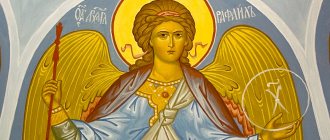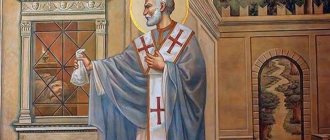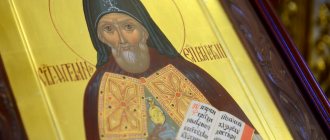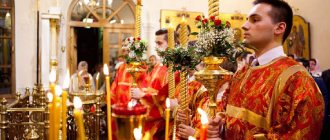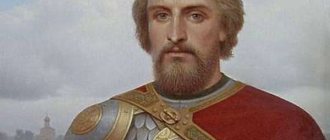Audio version of the article
- Episcopate of the Russian Orthodox Church
- Instructions for clergy and clergy during episcopal service
- Scheme: bishop's vestments
***
Bishop (from the Greek ἀρχιερεύς - chief priest, chief priest) -) the highest degree of the sacred hierarchy (priesthood); 2) the holder of this degree of priesthood (bishop, archbishop, metropolitan, exarch, patriarch); 3) the naming of Jesus Christ (Heb. 4:14), as is known, who did not belong to the Aaronic priesthood.
***
Is the word “bishop” found in Holy Scripture?
In the New Testament, the word “ἀρχιερεύς” denotes the Old Testament high priest, for example: Matthew 26:3; Luke 22:54; Acts 19:14; Acts 22:30; Acts 23:4. The same name is used in relation to Jesus Christ: Heb.4:14; Hebrews 5:10; Hebrews 9:11. The Russian (Synodal) translation of the Bible uses the word “high priest” in appropriate places.
Notes[ | ]
- In the Synodal Version: “<…> where Jesus entered as a forerunner for us, becoming a High Priest forever after the order of Melchizedek”
(Heb. 6:20) - Prot. Vladislav Tsypin. Canon law.
1994, p. 281 Archived February 28, 2008 on the Wayback Machine - Bishop's official. Book 2. The rite of naming, confession and ordination of the archbishop.
- Quote based on the Russian translation of the Catechism of the Catholic Church. Items 882 and 883 Archived December 14, 2007 on the Wayback Machine
- Bishop Igor Knyazev visited Ulan-Ude and Irkutsk.
What kind of obedience does a bishop bear?
The main obedience of a bishop (except for vicars) is the management of the diocesan clergy. He appoints abbots and priests to positions, establishes a ban on ministry or anathematizes (excommunicates). As a representative of the highest church authority, the bishop performs: a blessing for monastic tonsure; blessing for the construction of new churches and monastic monasteries; consecrates cathedrals, chapels, churches, antimensions; submits for approval the candidacies of rectors of seminaries, Orthodox academies, abbots and abbesses; approves the minutes of parish meetings, parish statutes; controls the level of education of the diocesan priesthood; coordinates the financial activities of the entrusted diocese and manages its property; addresses messages to clergy and parishioners.
The first Christian bishop is called the Apostle James, the brother of the Lord
The first Christian bishop is often called the Apostle James. This is not Jacob of Zebedee, but Jacob the brother of the Lord. There is practically no debate about the historicity of this man, because Josephus mentioned him in his writings.
According to legend, the Apostle James of the 70s is the first Christian bishop
Clement writes that Peter and John chose James as bishop of Jerusalem. Researchers suggest that this happened around 34. The Apostle James was the chairman at the first Jerusalem Council (approximately 48–50 AD)
Jacob
first bishop of Jerusalem. Chosen by Peter and John in 48-50
Tradition describes Jacob as an ascetic and ascetic, equally respected by both Christians and Jews.
The bishopric of the Apostle James lasted approximately 30 years, and around the year 64, his enemies threw him from the wing of the Jerusalem Temple and stoned him. The apostle is credited with two religious texts - canonical and apocryphal - as well as the composition of the liturgy of the Apostle James.
What kind of obedience does the diocesan bishop bear?
In administering the diocese, the bishop:
- takes care of maintaining faith, Christian morality and piety;
- oversees the correct performance of worship and the observance of church splendor;
- bears responsibility for the implementation of the resolutions of the Councils and the Holy Synod;
- convenes the diocesan meeting and the diocesan council and presides over them;
- if necessary, exercises the right of veto on decisions of the diocesan meeting with subsequent transfer of the relevant issue for consideration by the Holy Synod;
- approves the civil charters of parishes, monasteries, farmsteads and other canonical units included in the diocese;
- according to the canons, visits the parishes of his diocese and controls their activities directly or through his authorized representatives;
- has the highest supervisory supervision over diocesan institutions and monasteries included in its diocese;
- oversees the activities of the diocesan clergy;
- ordains clergy and blesses monastic tonsures;
- appoints (dismisses) rectors, parish priests and other clergy;
- submits for approval by the Holy Synod candidates for the positions of rectors of religious educational institutions, abbots (abbesses) and governors of monasteries of diocesan subordination and, based on the decision of the Holy Synod, issues decrees on the appointment of these officials;
- approves the composition of parish meetings;
- partially or completely changes the composition of the parish meeting if members of the parish meeting deviate from the canonical rules and regulations of the Russian Orthodox Church, as well as if they violate the parish charter;
- decides to convene a parish meeting;
- approves (dismisses) the chairmen of audit commissions and treasurers of parishes elected by the parish assembly;
- removes from parish councils members of parish councils who violate canonical norms and parish statutes;
- approves financial and other reports of parish councils and parish audit commissions;
- has the right to appoint (dismiss from office) the chairman of the parish council, the assistant rector (church warden) with their inclusion in (removal from) the parish meeting and the parish council;
- approves the minutes of parish meetings;
- provides vacations to the clergy;
- takes care of improving the spiritual and moral state of the clergy and raising their educational level;
- has care for the training of clergy and clergy, in connection with which it sends worthy candidates for admission to religious educational institutions;
- monitors the state of church preaching;
- petitions the Patriarch of Moscow and All Rus' to reward worthy clergy and laity with appropriate awards and, in accordance with the established procedure, rewards them himself;
- gives blessings for the establishment of new parishes;
- gives a blessing for the construction and repair of churches, houses of worship and chapels and takes care that their appearance and interior decoration correspond to the Orthodox church tradition;
- consecrates temples;
- has care for the state of church singing, icon painting and applied church arts;
- petitions government and administrative bodies for the return of churches and other buildings and structures intended for church purposes to the diocese;
- resolves issues related to the ownership, use and disposal of diocese property;
- manages the financial resources of the diocese, concludes contracts on its behalf, issues powers of attorney, opens accounts in banking institutions, has the right of first signature of financial and other documents;
- exercises control over the religious, administrative and financial activities of parishes, monasteries, educational institutions and other divisions of the diocese;
- issues its own executive and administrative acts on all issues of the life and activities of the diocese;
- confirms that all parishes, monasteries and other canonical divisions of the diocese located on its territory belong to the headed diocese;
- cares directly or through the relevant diocesan institutions: about works of mercy and charity; on providing parishes with everything necessary for performing divine services; about meeting other church needs.
In addition, while supervising canonical order and church discipline, the diocesan bishop has the right of paternal influence and discipline in relation to clergy, including punishment by reprimand, removal from office and temporary ban in the priesthood; admonishes the laity, if necessary, in accordance with the canons, imposes bans on them or temporarily excommunicates them from church communion. Serious offenses are referred to the ecclesiastical court; approves the penalties of the church court and has the right to mitigate them; in accordance with the canons, resolves issues arising during church marriages and divorces.
His responsibility is to submit to the Patriarch an annual report in the prescribed form on the religious, administrative, financial and economic state of the diocese and on his activities. He can also address archpastoral messages to the clergy and laity within his diocese.
Ordination
Photo: Elitsy.ru
At the beginning of the development of Christianity, there were no particularly serious requirements for the family status of a bishop. He could be either single or married. Over time, the clergy realized that the activity of a bishop in the Church requires his complete dedication, including renunciation of everything earthly. The bishop must be a monk - a warrior of Christ, and take a spiritual oath to the Heavenly Father. He must renounce his will and take a vow of celibacy and non-covetousness, that is, he completely renounces his property.
The teaching of the Church states that grace is transmitted to the bishop through the Sacrament of Ordination, performed by a council of bishops.
In modern practice, it is customary to appoint bishops from the monastic clergy. If the candidate is not a monk, then before being elected to a high rank he must take monastic vows. The reputation of a priest in terms of human and pastoral qualities must be impeccable.
We recommend reading: Hierarchy in the Orthodox Church
Literature[ | ]
- Barsov N.I.
Bishop // Encyclopedic Dictionary of Brockhaus and Efron: in 86 volumes (82 volumes and 4 additional). - St. Petersburg, 1890-1907. - Chapter "Bishops" Volume IV. “History of the Church during the period of the Ecumenical Councils” // Bolotov V.V.
Lectures on the history of the Ancient Church. - Markov N. F.
Bishop // Orthodox Theological Encyclopedia. - Petrograd, 1900-1911. - The ministry of church administration - episcopacy
//
Handbook of a clergyman
. T. 4.M.: Publishing house of the Moscow Patriarchate, 2001 - Tkachenko A. A., Bondach A. G., Zheltov M. S.
Bishop // Orthodox Encyclopedia. - M.: Tserkovno-nauchny, 2008. - T. XVIII: “Ancient Egypt - Ephesus.” — P. 509-522. — 752 p. — 39,000 copies. — ISBN 978-5-89572-032-5. - Bishop / Tsypin V. A. Prot. // Atmospheric dynamics - Railway junction. - M.: Great Russian Encyclopedia, 2007. - (Big Russian Encyclopedia: [in 35 volumes] / chief editor Yu. S. Osipov; 2004-2017, vol. 9). — ISBN 978-5-85270-339-2.
Who is a "bishop"
From the Greek, the word “bishop” is translated as “senior priest.” This is a rank of the highest church hierarchy. Currently, there are 4 episcopal titles: patriarch (the head of the local Church), metropolitan, archbishop and bishop. These titles (except that of patriarch) are not associated with various sacred powers. They testify only to personal honorary distinctions.
In the Orthodox Church, all bishops belong to the black clergy. Bishops can perform all divine services, consecrate chrism, antimensions, and churches. They are in charge of managing church affairs within the entrusted dioceses.
Priest - what does it mean?
In Orthodoxy, a priest may also be called a presbyter (from Greek “elder, head of the community”). Since the 4th century, the use of the name “priest” has become more frequent. In Rus', the common everyday name for a priest was the word “priest,” taken from the Greeks (from the Greek: “papas” - παπάς - “father”). Currently, a priest is an exclusively Orthodox priest. The priesthood is the second degree of priesthood. The senior priest is called the archpriest. The Christian community, which is called his parish, is subject to the priest's jurisdiction.
An Orthodox priest is often called a “shepherd.” He, like a shepherd, takes care of the “sheep” (believing parishioners), protecting them from the “wolves” (temptations of the devil). In this he imitates the Lord Jesus Christ, who, as “the good shepherd, lays down his life for the sheep” (Gospel of John, 10:11).
“A great person is a worthy priest - he is a friend of God, a constant executor of His will. If he performs, for example, a sacrament, he is the direct, closest, immediate executor of His will; whether he baptizes, he fulfills the command of the Lord: going... baptizing (Gospel of Matthew, 28:19); whether he performs the Sacrament of the Body and Blood - he represents His Person - he fulfills His word of love: do this in remembrance of Me (Gospel of Luke, 22:19); whether he teaches, he also fulfills His direct commandment; whether he shepherds - he represents the good Shepherd and the Chief of the shepherds appointed by the Spirit of God" (Righteous John of Kronstadt, 1829-1908).
It is customary to address a priest with a name, for example, Father Roman, or traditionally “father.”
Hierarchy of clergy
Bishop (bishop), priest (priest), deacon are the names of holy orders in Orthodoxy. The hierarchy in the Orthodox Church was established by Jesus Christ himself through the apostles.
“And He appointed some apostles, some prophets, some evangelists, some shepherds and teachers, for the equipping of the saints for the work of ministry, for the edifying of the body of Christ” (Ephesians 4:11).
In the first centuries of the history of the Church, monks could not have priestly rank. However, from the 4th century the ban was lifted. Monks who have accepted the rank of priest began to be called hieromonks, and hierodeacons - those with the rank of deacon. Priest-monks make up the black clergy, married clergy make up the white clergy.
At ordination, clergy receive the gift of the grace of the Holy Spirit. The priesthood is entrusted with the functions of external leadership of church life in accordance with the Holy Scriptures and the canons (rules) of Orthodoxy. Clergy (bishops and priests) perform Church Sacraments, lead public services in churches, and spiritually guide believers.
The most important thing in the ministry of clergy is the performance of the Church Sacraments. In the Orthodox Church there are seven of them: baptism, confirmation, consecration of oil, marriage, repentance, Eucharist, ordination. All Sacraments can be performed only by the bishop. A priest cannot perform the sacrament of ordaining another person as a priest or deacon.
